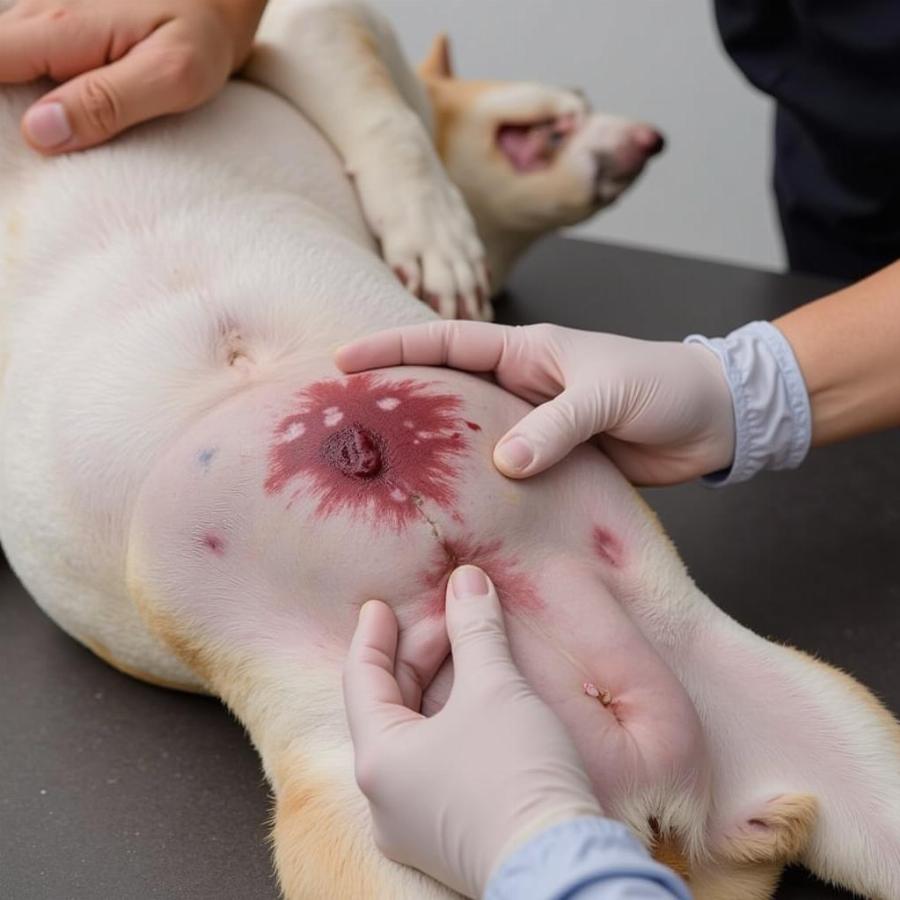Bruising on a dog’s belly can be alarming for any pet owner. While some bruises are harmless, others can indicate a more serious underlying health issue. This article will explore the various causes of bruising on dogs belly, explain how to recognize the symptoms, and guide you through the appropriate treatment options. Understanding the potential reasons for these bruises can help you make informed decisions about your dog’s care and ensure they receive the best possible treatment.
Understanding Bruising in Dogs
A bruise, also known as a contusion, occurs when small blood vessels under the skin break and leak blood into the surrounding tissues. This results in the characteristic discoloration we associate with bruising. In dogs, bruises can appear on any part of the body, including the belly, which is particularly vulnerable due to its thinner skin and lack of protective fur.
Common Causes of Bruising on a Dog’s Belly
Several factors can contribute to bruising on a dog’s belly, ranging from minor injuries to more serious medical conditions. Let’s explore some of the most common culprits:
Trauma or Injury
One of the most frequent causes of bruising is physical trauma. This could be anything from a bump against furniture to a more serious fall or accident. Playful roughhousing with other dogs can also lead to minor injuries and subsequent bruising.
Medications
Certain medications, such as anticoagulants (blood thinners) and steroids, can increase a dog’s susceptibility to bruising. If your dog is on any medication, consult your veterinarian to determine if it could be contributing to the bruising.
Bleeding Disorders
Underlying bleeding disorders, such as Von Willebrand’s Disease or hemophilia, can impair the blood’s ability to clot effectively, making dogs more prone to bruising.
Immune-Mediated Thrombocytopenia (ITP)
ITP is a condition where the immune system mistakenly attacks platelets, which are essential for blood clotting. This can lead to easy bruising and bleeding.
Cushing’s Disease
Cushing’s disease, caused by an overproduction of cortisol, can also cause thinning of the skin, making dogs more susceptible to bruising.
 Veterinarian Examining a Dog's Belly Bruise
Veterinarian Examining a Dog's Belly Bruise
Recognizing the Symptoms
Bruising often appears as a discolored area on the skin, ranging from red to purple, blue, or even black. The area might also be slightly swollen or tender to the touch. If the bruise is accompanied by other symptoms, such as lethargy, loss of appetite, or pale gums, it’s crucial to seek veterinary attention immediately.
When to Seek Veterinary Care
While minor bruises might heal on their own, it’s important to consult your veterinarian if:
- The bruise is large or painful.
- The bruise is accompanied by other symptoms.
- The bruise doesn’t improve within a few days.
- You suspect an underlying medical condition.
Diagnosing the Cause of Bruising
Your veterinarian will perform a thorough physical exam and may recommend additional tests, such as blood work or imaging, to determine the underlying cause of the bruising.
Treatment Options
Treatment for bruising depends on the underlying cause. For minor bruises caused by trauma, rest and cold compresses might be sufficient. However, if a medical condition is identified, your veterinarian will recommend appropriate treatment, which may include medications or other therapies.
What should I do if my dog has a bruise on its belly?
First, try to determine if there was any recent trauma that could have caused the bruise. If you are unsure of the cause or the bruise is accompanied by other symptoms, it’s best to consult your veterinarian.
Can bruises on a dog’s belly be serious?
While some bruises are harmless, they can sometimes indicate a serious underlying medical condition. It’s crucial to monitor the bruise and seek veterinary care if necessary.
Conclusion
Bruising on a dog’s belly can be caused by a variety of factors, from simple bumps and bruises to more serious medical conditions. By understanding the potential causes and recognizing the symptoms, you can ensure your furry friend receives the appropriate care and treatment. Remember, early diagnosis and intervention are crucial for managing any underlying health issues and ensuring your dog’s well-being. If you notice bruising on your dog’s belly, don’t hesitate to contact your veterinarian.
FAQs
-
What color are bruises on dogs? Bruises on dogs can vary in color from red to purple, blue, or even black.
-
How long do bruises on dogs last? Minor bruises typically heal within a few days to a week, while more severe bruises can take longer.
-
Can I put Neosporin on my dog’s bruise? It’s best to consult your veterinarian before applying any medication to your dog’s bruise.
-
Are belly bruises common in dogs? Bruises can occur on any part of a dog’s body, including the belly, which can be more susceptible due to thinner skin.
-
When should I be concerned about a bruise on my dog? You should be concerned if the bruise is large, painful, accompanied by other symptoms, or doesn’t improve within a few days.
-
What can cause unexplained bruising in dogs? Unexplained bruising can be a sign of underlying medical conditions such as bleeding disorders or ITP.
-
Can stress cause bruising in dogs? While stress itself doesn’t directly cause bruising, it can sometimes weaken the immune system, potentially making a dog more susceptible to conditions that can cause bruising.
Related Articles
Beaut Dogs is your trusted source for all things related to dog care, providing expert advice and guidance on everything from breed selection to health and nutrition. For personalized support and detailed answers to your dog-related questions, contact us at Email: [email protected]. We’re here to help you provide the best possible care for your beloved companion. Beaut Dogs, your partner in canine companionship.